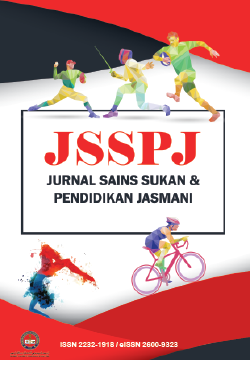Aerobic Fitness Level Among University Athletes During Movement Control Order in Malaysia
DOI:
https://doi.org/10.37134/jsspj.vol11.2.6.2022Keywords:
Aerobic fitness, Movement control orderAbstract
Aerobic fitness level is one of the important components to maintain and improve athletes' performance. Movement Control Order (MCO) is hypothesized to affect athletes in terms of sustaining their aerobic fitness level. The purpose of this present study was to identify the aerobic fitness level among university athletes during the MCO. Fifty university athletes (age: 19 – 26 years old) from Sultan Idris Education University (UPSI) had participated in this study. The athletes completed a CLINIMEX aerobic fitness questionnaire through Google Form to estimate their aerobic fitness level. As the result, the minimum and maximum values of aerobic fitness obtained from the 50 university athletes were 9 and 16 METs. The aerobic fitness level among university athletes overall was 10.89 ± 1.83 METs. The aerobic fitness level among university athletes for males was 11.01 ± 1.89 METs while for females 10.41 ± 1.56 METs. It has been identified that aerobic fitness level among university athletes during movement control order is at a vigorous-intensity activity that is 6.0 METs and above. In conclusion, high level of aerobic fitness among university athletes during MCO shows that despite the limitation of space and exercise equipment, they still involved in physical activity.
Downloads
References
Androulakis-Korakakis, P., Langdown, L., Lewis, A., Fisher, J. P., Gentil, P., Paoli, A., & Steele, J. (2018). Effects of exercise modality during additional “high-intensity interval training” on aerobic fitness and strength in powerlifting and strongman athletes. The Journal of Strength & Conditioning Research, 32(2), 450-457.
Araújo, C. G. S., Castro, C. L., & Franca, J. F. (2019). CLINIMEX Aerobic Fitness Questionnaire: proposal and validation. International Journal of Cardiovascular Sciences, 32, 331-342.
Baumgartner, T. A., & Jackson, A. S. (1998). Measurement for evaluation in physical education and exercise science (6th ed.). WCB/McGraw-Hill.
Castañeda-Babarro, A., Arbillaga-Etxarri, A., Gutiérrez-Santamaría, B., & Coca, A. (2020). Physical activity change during COVID-19 confinement. International journal of environmental research and public health, 17(18), 6878.
Corbin, C. B., Corbin, W. R., Welk, G. J., & Welk, K. A. (1997). Concepts of physical fitness (14th ed.). Mcgraw-Hill.
de Groot, G. C., & Fagerström, L. (2010). Older adults' motivating factors and barriers to exercise to prevent falls. Scandinavian Journal of Occupational Therapy, 18(2), 153–160. https://doi.org/10.3109/11038128.2010.487113
Fikenzer, S., Fikenzer, K., Laufs, U., Falz, R., Pietrek, H., & Hepp, P. (2020). Impact of COVID-19 lockdown on endurance capacity of elite handball players. The Journal of sports medicine and physical fitness.
Kalinowski, P., Myszkowski, J., & Marynowicz, J. (2021). Effect of online training during the COVID-19 quarantine on the aerobic capacity of youth soccer players. International journal of environmental research and public health, 18(12), 6195.
Klika, B., & Jordan, C. (2013). High-intensity circuit training using body weight: Maximum results with minimal investment. ACSM's Health & Fitness Journal, 17(3), 8-13.
Kodama, S., Saito, K., Tanaka, S., Maki, M., Yachi, Y., Asumi, M., Sugawara, A., Totsuka, K., Shimano, H., Ohashi, Y. and Yamada, N. (2009). Cardiorespiratory fitness as a quantitative predictor of all-cause mortality and cardiovascular events in healthy men and women: a meta-analysis. Jama, 301(19), 2024-2035.
Kraemer, W. J., Fleck, S. J., & Deschenes, M. R. (2015). Exercise physiology: integrating theory and application (2nd ed.). Lippincott Williams & Wilkins.
Lu, Y., Wiltshire, H. D., Baker, J. S., & Wang, Q. (2021). The effects of running compared with functional high-intensity interval training on body composition and aerobic fitness in female university students. International journal of environmental research and public health, 18(21), 11312.
Malina, R. M. (2010). Physical activity and health of youth. Ovidius University Annals, Series Physical Education & Sport/Science, Movement & Health, 10(2).
Mandsager, K., Harb, S., Cremer, P., Phelan, D., Nissen, S. E., & Jaber, W. (2018). Association of cardiorespiratory fitness with long-term mortality among adults undergoing exercise treadmill testing. JAMA network open, 1(6), e183605-e183605.
Marques, A., Hillman, C., & Sardinha, L. (2018). Physical activity, aerobic fitness and academic achievement. Health and academic achievement, 235.
Maugeri, G., Castrogiovanni, P., Battaglia, G., Pippi, R., D'Agata, V., Palma, A., Di Rosa, M. & Musumeci, G. (2020). The impact of physical activity on psychological health during Covid-19 pandemic in Italy. Heliyon, 6(6), e04315.
Moreno-Tenas, A., León-Zarceño, E., & Serrano-Rosa, M. A. (2021). The use of online training tools in competition cyclists during COVID-19 confinement in Spain. Frontiers in psychology, 12, 622905.
Myers, J., Do, D., Herbert, W., Ribisl, P., & Froelicher, V. F. (1994). A nomogram to predict exercise capacity from a specific activity questionnaire and clinical data. The American journal of cardiology, 73(8), 591-596.
Parpa, K., & Michaelides, M. (2021). The impact of COVID-19 lockdown on professional soccer players' body composition and physical fitness. Biology of Sport, 38(4), 733-740.
Schneider, F., Runer, A., Burkert, F., Aspang, J. S. U., Reider, S., Schneider, H., & Pocecco, E. (2022). Digital Workout Versus Team Training: The Impact of the COVID-19 Pandemic on Athletes. Sports medicine international open, 6(01), E18-E24.
Singh, R. K., Rastogi, J., & Sekara, C. Effect of Covid-19 Lockdown on Sports Performance Parameters of Competitive Athletes. Journal of Applied Sports Sciences, 1, 16-27.
Tremblay, M. S., Colley, R. C., Saunders, T. J., Healy, G. N., & Owen, N. (2010). Physiological and health implications of a sedentary lifestyle. Applied physiology, nutrition, and metabolism, 35(6), 725-740.
Downloads
Published
Issue
Section
License
Copyright (c) 2022 Mohd Aminur Izuan Awang, Norhazira Abdul Rahim, Nurul Fadhilah Abdullah, Nor Aijratul Asikin Mohamad Shalan

This work is licensed under a Creative Commons Attribution-NonCommercial-ShareAlike 4.0 International License.





